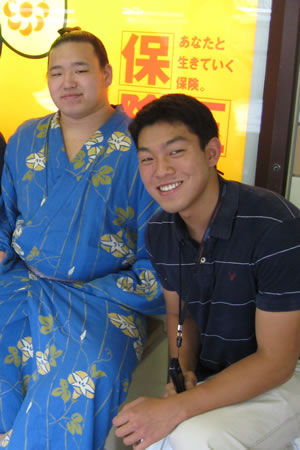


Alumni Update
I am pleased to inform the NanoJapan program that the manuscript that includes portions of the work I did at the University of Tokyo through NanoJapan program has been recently been accepted for publication in Physical Review B. The official publication/citation should be available soon.
NanoJapan Research Overview
This past summer I worked in the Maruyama-Shiomi lab in the mechanical engineering department at the University of Tokyo. The lab focuses on the growth and characterization of single-walled carbon nanotubes, though since both Maruyama-sensei and Shiomi-sensei have backgrounds in thermodynamics, there is some research in this area as well. Maruyama-sensei really works hard to pick a project that fits the student’s interests and allows the student to contribute to the lab. In addition, the Maruyama-Shiomi laboratory is a very diverse lab that is really quite comfortable for foreign students: there are several foreign students continuously visiting and so all PhD students and above speak English quite well. Though the Master's and undergraduate students tend not to use English, they do understand and can communicate when necessary. Some Master's students in particular are very open to using English. Really, the laboratory interaction is not so different from the experience you would get from working in an American lab.
Because I come from a bioengineering background and not a mechanical engineering or physics background, the project Maruyama-sensei selected for me was quite different than what was being done by the rest of the lab. In fact, the density gradient separation technique, which is a common method used in biochemistry, is quite new to the lab: though a previous NanoJapan student had worked with the equipment, the graduate student who worked primarily with her had since graduated and another who had assisted with the project was busy with her Master’s thesis. Because of this, I was given quite a bit of independence on this project and had to learn quite a bit on my own.
Though this project did not quite fall into my academic major, I have been given the opportunity to continue this research back at Rice University under Professor Junichiro Kono. I take this experience as an invaluable introduction to the nanotechnology field, which I am really interested in. I hope to use the knowledge gained from this experience and perhaps explore opportunities in the growing bionanotechnology field. In addition, I feel that I really gained a lot in terms of research experience as well as better understanding Japanese culture.
Meaning of NanoJapan
To me, the NanoJapan Program provided an undergraduate research opportunity introducing me to nanotechnology in the one of the leading countries in nanotechnology as well as a study abroad opportunity. This last particular benefit of the program is especially important for engineering majors since it is difficult to study outside of our own institutions yet equally as important since the scientific community is always becoming more global and less United States-centric. Such a program which combined three important aspects to my academic interests was truly ideal.
Daily Life in Japan
I find that there are really two different types of NanoJapan internship experiences: those that are more research-oriented and those that are more culturally-enriching. My experience was definitely more research-oriented, perhaps because I was more familiar with Japanese culture in comparison with other participants having visited Japan before and having relatives living in Japan and so did not feel as obligated to entice this opportunity. In addition, because I was given quite a bit of independence in my project and the graduate students that I worked most closely with were Chinese and American, I did not necessarily have as much Japanese interaction as some of the other NanoJapan students.
During my research internship, I lived in a guesthouse (a house where rooms are rented out and there is a shared kitchen and bathroom) where the room was rather small and where my neighbors were not the most amiable people. Because of this, I tended to not spend much time at “home”. My typical workday consisted of me going in around 9 or 10am, having lunch around noon, working until dinner around 5 or 6pm when I would either go to the school cafeteria or some other restaurants around Hongo (the town the campus is located in), and then perhaps working until 10pm. Food can be had starting around $15 a day despite Hongo’s rather pricy restaurants. I chose not to cook because of my reluctance to spend much time at the guesthouse and also because I found that it was not much cheaper. I traveled quite a bit during the weekends, and would typically head out Friday evening.
My favorite experience in Japan was...
This is a tie between watching sumo wrestling and climbing Mt. Fuji to watch the sunrise.
While I was in Japan I wish I had...
Practiced speaking in Japanese more.